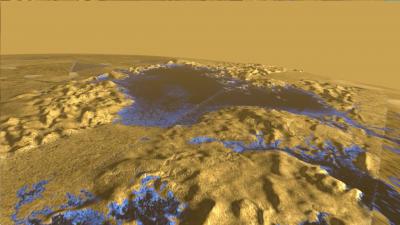Surface of Titan Sea is mirror smooth, Stanford scientists find

This false-color image of the surface of Titan was made using radar measurements made by NASA's Cassini spacecraft. The spacecraft revealed that the surface of Ligeia Mare, Titan's second largest lake, is unusually still, most likely due to a lack of winds at the time of observation. Credit: Courtesy of Howard Zebker
The measurements, made in 2013 by NASA's Cassini spacecraft, reveal that the surface of Ligeia Mare, Titan's second largest sea, possesses a mirror-like smoothness, possibly due to a lack of winds.
“If you could look out on this sea, it would be really still. It would just be a totally glassy surface,” said Howard Zebker, professor of geophysics and of electrical engineering at Stanford who is the lead author of a new study detailing the research.
The findings, recently published online in Geophysical Research Letters, also indicate that the solid terrain surrounding the sea is likely made of solid organic materials and not frozen water.
Saturn's second largest moon, Titan has a dense, planet-like atmosphere and large seas made of methane and ethane. Measuring roughly 260 miles (420 km) by 217 miles (350 km), Ligeia Mare is larger than Lake Superior on Earth. “Titan is the best analog that we have in the solar system to a body like the Earth because it is the only other body that we know of that has a complex cycle of solid, liquid, and gas constituents,” Zebker said.
Titan's thick cloud cover makes it difficult for Cassini to obtain clear optical images of its surface, so scientists must rely on radar, which can see through the clouds, instead of a camera.
To paint a radar picture of Ligeia Mare, Cassini bounced radio waves off the sea's surface and then analyzed the echo. The strength of the reflected signal indicated how much wave action was happening on the sea. To understand why, Zebker said, imagine sunlight reflecting off of a lake on Earth. “If the lake were really flat, it would act as a perfect mirror and you would have an extremely bright image of the sun,” he said. “But if you ruffle up the surface of the sea, the light gets scattered in a lot of directions, and the reflection would be much dimmer. We did the same thing with radar on Titan.”
The radar measurements suggest the surface of Ligeia Mare is eerily still. “Cassini's radar sensitivity in this experiment is one millimeter, so that means if there are waves on Ligeia Mare, they're smaller than one millimeter. That's really, really smooth,” Zebker said.
One possible explanation for the sea's calmness is that no winds happened to be blowing across that region of the moon when Cassini made its flyby. Another possibility is that a thin layer of some material is suppressing wave action. “For example, on Earth, if you put oil on top of a sea, you suppress a lot of small waves,” Zebker said.
Cassini also measured microwave radiation emitted by the materials that make up Titan's surface. By analyzing those measurements, and accounting for factors such as temperature and pressure, Zebker's team confirmed previous findings that the terrain around Ligeia Mare is composed of solid organic material, likely the same methane and ethane that make up the sea. “Like water on Earth, methane on Titan can exists as a solid, a liquid, and a gas all at once,” Zebker said.
Titan's similarities to Earth make it a good model for our own planet's early evolution, Zebker said. “Titan is different in the details from Earth, but because there is global circulation happening, the big picture is the same,” he added. “Seeing something in two very different environments could help reveal the overall guiding principles for the evolution of planetary bodies, and help explain why Earth developed life and Titan didn't.”
Ker Than is associate director of communications for the Stanford School of Earth Sciences.
Media Contact
All latest news from the category: Earth Sciences
Earth Sciences (also referred to as Geosciences), which deals with basic issues surrounding our planet, plays a vital role in the area of energy and raw materials supply.
Earth Sciences comprises subjects such as geology, geography, geological informatics, paleontology, mineralogy, petrography, crystallography, geophysics, geodesy, glaciology, cartography, photogrammetry, meteorology and seismology, early-warning systems, earthquake research and polar research.
Newest articles

Silicon Carbide Innovation Alliance to drive industrial-scale semiconductor work
Known for its ability to withstand extreme environments and high voltages, silicon carbide (SiC) is a semiconducting material made up of silicon and carbon atoms arranged into crystals that is…

New SPECT/CT technique shows impressive biomarker identification
…offers increased access for prostate cancer patients. A novel SPECT/CT acquisition method can accurately detect radiopharmaceutical biodistribution in a convenient manner for prostate cancer patients, opening the door for more…

How 3D printers can give robots a soft touch
Soft skin coverings and touch sensors have emerged as a promising feature for robots that are both safer and more intuitive for human interaction, but they are expensive and difficult…




















